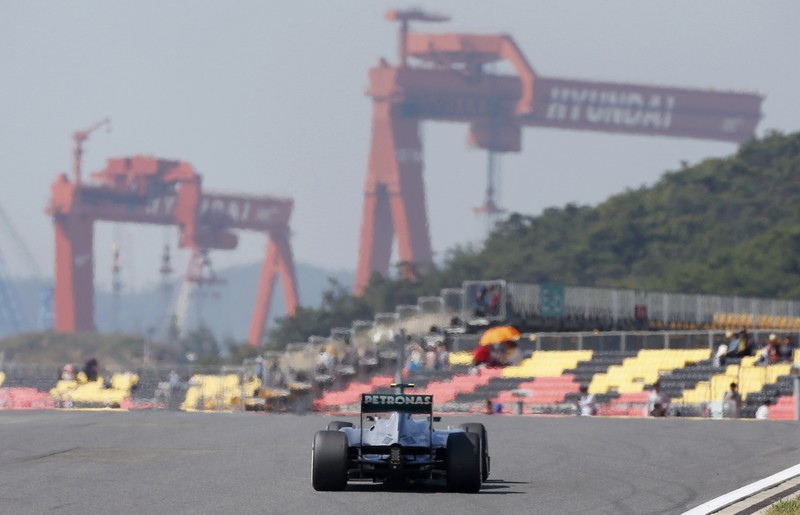Korea, the second of three races in Formula One's late-season Far East swing, hosted its fourth and possibly final Grand Prix on Sunday, with organisers reported to be in negotiations with Bernie Ecclestone about the amount it pays to stage its annual race heading into what is supposed to be the final year of its original five-year deal.
The track, built close to the shipping port town of Mokpo, and, in the continuing absence of the once-proposed leisure and marina development, surrounded by marshland, is by some distance the most unloved of the 19 Grand Prix venues. The main bugbear of the Formula One community, many of whom hightailed it to Tokyo immediately after the race ahead of this weekend’s Japanese Grand Prix, seems to be the distance from Seoul – three hours by train, four and a half on the road – and the lack of a nearby international airport. A perceived lack of local interest hardly helps either, although according to race organisers some 164,152 people passed through the gates throughout the weekend, including 79,057 people for Sunday's race. That compares pretty favourably with the 87,509 who attended the Singapore Grand Prix, one of the Formula One paddock's favourite races, two weeks ago, even if Singapore's three-day crowd was significantly higher at 262,527. Korea's interest in Formula One is a slow-burner, not helped by the inaccessibility of its circuit and the lack of local corporate support, but it is far from the total write-off some would have you believe.
Putting teams to the test
With continuing speculation that it may install floodlights and stage a twilight Grand Prix to celebrate its tenth anniversary next year, the Bahrain International Circuit has won the battle to stage Formula One's warm-weather pre-season testing sessions in February. The circuit will be the stage for testing between 19th and 22nd February and 27th February to 2nd March, seeing off competition from the Yas Marina circuit in Abu Dhabi and the Dubai Autodrome. It is the return of in-season testing, however, which is causing concern for Formula One's smaller teams, with suggestions that the four two-day sessions, which will be held in the week after races in Bahrain, Spain, Britain and Abu Dhabi, may cost teams as much as US$8 million over the course of the year. Force India team manager Andy Stevenson offered this honest assessment: “We think there is going to be quite a large cost implication, especially in the way that we run our team and with the resources we have available to us now, it won't be possible for us to attend the four tests as planned.”
No titles at McLaren
There is still no word on McLaren's new title sponsor, with just five races to go until Vodafone withdraws from Formula One at the end of the season. Cards are being kept close to chests, although Procter & Gamble brand Gillette, with whom McLaren signed a deal covering Asia in April this year, is considered one possibility for a larger role. However, with Honda understood to be providing commercial support as well as a supply of engines from 2015 onwards, 2014 may turn out to be a holding year commercially as well as technically for the British team. Its most recent financial results, recently revealed, show the McLaren Racing division lost UK£3.1 million in 2012, following a UK£22.3 million profit in 2011. That has been put down to an increase in costs, including its changing relationship with Mercedes – the team is paying for engines where previously Mercedes parent Daimler was a shareholder – and growing travel costs. There are signs the team is willing to play the long-game, however, with the accounts noting that 'looking forward the Honda arrangement will transform our business model'. The McLaren of 2015 will, it seems, be substantially different from the 2013 version, although thanks to its dismal on-track performance this year – it is looking increasingly unlikely the team will score even one podium finish – it is bracing itself for a significantly lower share of prize money at the end of the season.
Engine notes
A couple of engine notes, ahead of the largest change to Formula One's technical regulations in a generation and the introduction of highly efficient, albeit expensive, 1.6 litre turbos next season: Sauber confirmed in Korea that it has agreed a new 'multi-year' deal with Ferrari, starting in 2014. Sauber has run Ferraris since BMW left Formula One at the end of 2009 and the Swiss outfit fell back into the hands of founder Peter Sauber. The team will join Marussia as a Ferrari customer, with the Anglo-Russian team confirming over the weekend that it will retain driver Jules Bianchi for a second season. Bianchi, who has had a largely impressive debut year despite the deficiencies of his car, is a member of Ferrari's young driver programme and is considered a long-term prospect for the Italian team. With Caterham confirming a new three-year contract with Renault in Singapore, every team has their engine plans in place for 2014. Renault is supplying Red Bull, Lotus, Caterham and Toro Rosso, with the latter switching from Ferrari, while Mercedes has added Williams, a Renault customer this year, to its deals with Force India and McLaren.

